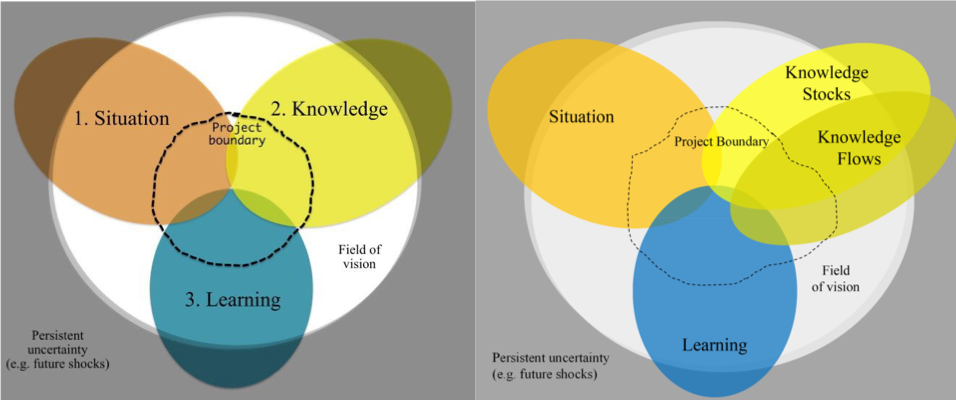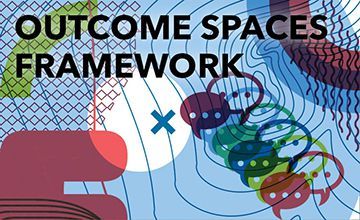Outcome spaces framework
A framework to plan for preferred outcomes in transdisciplinary projects.
Mitchell C, Fam D 2020. Outcome spaces framework. td-net toolbox profile (9). Swiss Academies of Arts and Sciences: td-net toolbox for co-producing knowledge. www.transdisciplinarity.ch/toolbox. doi.org/10.5281/zenodo.3717200
What is the outcome spaces framework? | The outcome spaces framework provides a structure to reflect on, and classify participants’ preferred outcomes in a transdisciplinary project in a differentiated way. Three key realms of transdisciplinary outcome spaces are distinguished – situation, knowledge and learning – elaborated as (1) an improvement within the situation or field of inquiry, (2) the generation of relevant stocks and flows of knowledge, including scholarly knowledge and other societal knowledge forms (3) mutual and transformational learning by researchers and research participants to increase the likelihood of persistent change. |
Why should it be applied? | Participants of a knowledge co-production process enter a project for different reasons and have different expectations about the project’s outcomes. An early discussion helps to bring to the foreground these differences, make them transparent and jointly clarify which of them are preferred by the project team and within or beyond the boundaries of the project. If these expectations remain implicit, they have the potential to trigger long debates, for instance, about the methodological approach to take or which stakeholders to engage, which may be due to and rooted in different expectations about project outcomes. In addition, participants become aware that there are different dimensions of outcomes. Participants who, for instance, primarily expect a certain outcome in terms of changes in the situation are ideally asked to reflect on outcomes contributing to knowledge or learning. |
When should it be applied? | Ideally the outcome spaces framework should be used at the very beginning of a project to negotiate and plan for preferred outcomes at the end. The outcome spaces could also be used when participants of a project have differing, one–dimensional or fuzzy expectations about the outcomes of a project. As shown in an experience report, the outcome space framework can also be used for mid-term evaluations. At this stage it can help to compare the outcomes intended at the start of a project with the actual outcomes being realised. Through this comparison it can help identify changes in focus needed to meet the preferred outcomes in the remainder of the project. |

How does it work? | 1) A facilitator introduces the conceptual map of the outcome spaces displayed on a paperboard or the like (see Figure) and explains the three spaces: "The first outcome space is improvement within the ‘situation’ or field of inquiry, that is, the everyday world of our research collaborators and clients. Changes in the situation may be institutional (e.g. a shift in a policy), or biophysical (e.g. more efficient water use). Secondly, the generation of relevant stocks and flows of knowledge, including rigorous scholarly knowledge and other forms of knowledge (e.g. decision-making tools, industry reports, interactive websites, apps) in order to make insights accessible and meaningful to both research participants i.e. clients and collaborators, as well as broader beneficiaries i.e. industry sectors and/or citizens. Finally, outcomes of mutual and transformational learning by both researchers and research participants increase the likelihood of persistent change." (Mitchell, 2015 #1473, p. 90) The facilitator may explain the difference between knowledge stocks – (i.e. doing research, creating new knowledge, rigorous scholarly knowledge, producing scientific papers), and knowledge flows – (i.e. making research available to those that need or want it in ways that are meaningful and useful (Duncan et al. 2020)). 2) The participants write their expectations on cards. They might provide several expectations for the same space and not necessarily expectations for all spaces. 3) Participants stick their cards to the map, locating it to one of the outcome spaces. 4) The facilitator goes through each space and asks the participants to say a few words about their expectations. (If the aim is to clarify if, for instance, researchers have other expectations than representatives of other sectors of society, cards with different colours for the different kinds of participants can be used). 5) If needed, the group discusses and decides for each expectation whether it falls inside or outside the boundaries of the project and how these preferred outcomes might be incorporated into project planning. |
How are thought-styles bridged? | Learning which outcomes other participants expect enhances getting to know each other and each other’s thought style better. |
What’s the output/outcome? | The outcome is a map that compiles the project outcomes expected by the collective of project participants. It sorts these expectations in relation to the situation under consideration, to knowledge stocks and flows and to learning. With step 5, the expected outcomes are further classified into those who fall inside or outside the project’s boundaries, respectively. |
Who participates in what role? | The participants are project team members who individually reflect on their own preferred outcomes before sharing them with the group. A facilitator guides through the process. |
What do I need to prepare? | The facilitator needs to prepare the map of the outcome spaces to be displayed on a paperboard, table or the like, cards to stick or pin on the map and pens. |


